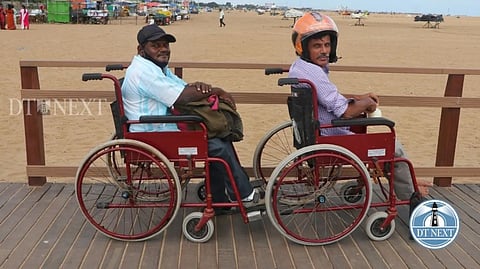

CHENNAI: In the backdrop of International Day of Persons with Disabilities (PwD) that recently passed us by, it seems pertinent to examine the progress made with regard to the inclusion and mainstreaming of differently-abled people in India.
As per Census 2011, our population stood at 1.23 billion, of which 2.1% or roughly 21 million people are said to be differently-abled.
The population of differently-abled individuals in emerging economies stood at 400 mn people, and a majority of them are poor.
The WHO reports that PwD are severely deprived of opportunities for social and economic development, with basic facilities like healthcare, education and employment being denied to this vulnerable group. Estimates reveal that 70 per cent of the PwD are unemployed.
One must consider how well we have factored in the notion of accessibility and inclusivity in the most frequented public spaces in India. Let’s take the example of public transport, a facility that differently-abled individuals have as much right to use as anybody else.
However, thanks to faulty infrastructure and myopic design sensibilities, travelling by State buses in India is nothing short of a nightmare for differently-abled individuals.
Apart from the absence of lifts or ramps to help them climb onto such vehicles, the poorly maintained roads make it next to impossible for people to ply their wheelchairs on the streets.
Even public and private buildings including offices, educational institutions, supermarkets, malls and parks are built keeping the majority in mind, which is a violation of the Rights of Persons with Disabilities Act, 2016.
The positioning or placement of ticket counters, dispensers, or even entry and exit points, stairs, doorknobs, and everything in between, whether it’s at an airport or a railway station or bus depot is done considering able-bodied people and not PwD.
Only recently did public restrooms begin meeting the needs of PwD with smart innovations.
The Madras High Court had cleared the State’s decision earlier this year to introduce over 2,200 new buses in Chennai suited for use by PwD.
The procurement of these buses had been stalled last year on account of the fact that these low-floored buses would be impacted by the bad state of city roads. What has also been a pain point for the government is that it has failed to monitor new projects for accessibility and disabled-friendly infrastructure options.
The State government was also given time till June 2022 to revamp existing government structures and make them more accessible.
The Centre had also come up with an Accessible India campaign, which was focussed on evaluating the design of disabled-friendly buildings. However, no audit details pertaining to the project are available in the public domain.
However, there are a few silver linings in Tamil Nadu. Chief Minister MK Stalin had announced the implementation of a differently-abled rights scheme, at an outlay of Rs 1,763 cr.
Apart from this, the monthly pension provided to PwD has been increased to Rs 1,500. More recently, Chennai had the proud distinction of being home to India’s very first permanent ramp for PwD and senior citizens at Marina Beach.
While these are encouraging initiatives, we need to realise that there is more scope to improve the lives of PwD.
Going forth, all our public, private initiatives and urban or rural infrastructure projects will need to mind the interests of all demographics including PwD.
Visit news.dtnext.in to explore our interactive epaper!
Download the DT Next app for more exciting features!
Click here for iOS
Click here for Android